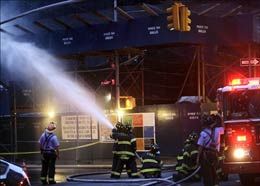By FireRescue1 Staff
 AP Photo/Seth Wenig Firefighters spray water on smoldering debris that fell off the Deutsche Bank building after the fire. |
NEW YORK — New building inspection guidelines have been drawn up by the FDNY in the wake of the Deutsche Bank fire in August that claimed the lives of two firefighters.
Fire Commissioner Nicholas Scoppetta said the changes will greatly improve safety for firefighters and the public. Mayor Michael Bloomberg ordered a comprehensive review of the FDNY’s citywide building inspection program a week after the deaths of Joseph Graffagnino and Robert Beddia.
Reports after the blaze claimed that top fire officials were told by the city’s Department of Buildings three months before the Deutsche Bank fire that they were no longer responsible for inspecting the troubled skyscraper near ground zero.
Fire Commissioner Scoppetta said the changes to the inspection program include increasing inspection time and providing more tools and information to FDNY members.
“The inspection program is a critical component of ensuring public safety by allowing firefighters to get a first-hand look at buildings before an emergency arises,” he said. “These initial steps will give firefighters a better opportunity to uncover any challenges they may face while fighting fires.”
The following changes have been added to the program, including the name — from Apparatus Field Inspection Duty (AFID) to Building Inspection Safety Program (BISP) — to emphasize how safety is directly related to inspection work:
• Implementation of a third inspection period each week for every field unit, increasing the amount of time — six to nine hours — units will be scheduled for weekly building inspections. (Less than half of the scheduled inspection time for field units actually gets spent inspecting buildings due to emergency responses, inclement weather, etc.)
• Creation of a new computer software program which indexes all buildings — more than 75 feet high that are under construction or demolition — for each individual field unit according to their particular area. This program is now tracking inspections and electronically reminds units when their next inspection is due.
• Added oversight of field inspections by or at the Borough Command level, and additional oversight with compliance measures implemented at FDNY headquarters in Brooklyn.
• The City’s Department of Buildings now notifies the FDNY of new building or demolition permits issued. That information will be given to field units, which were previously instructed to canvass their areas to learn this information.
Other initiatives also are being developed to streamline building information and increase training at every level. They include:
Computerization — The FDNY is currently working with the City’s Department of Information Technology and Telecommunications in planning an integration of all of our building inspection information, as well as improved information-sharing with the Department of Buildings and other City agencies.
Partnership with DOB — The FDNY and DOB are partnering on a number of information-sharing initiatives, including the Fast-Track Pilot Program which enables chief officers to enter critical information about buildings directly into the DOB’s Business Information System. This drastically reduces the notification and action time required for DOB officials to address structural concerns that could endanger our members or the public. A pilot program in Divisions 6 and 7 in the Bronx was successful, and soon, it will be expanded to other boroughs.
Increased Training — With the expansion of proby school at the Fire Academy, additional material on fire prevention and inspections has been added to the curriculum. Newly promoted officers at every level also will receive additional training on building inspections in their promotional courses, and a new course is being developed for fire prevention coordinators.

